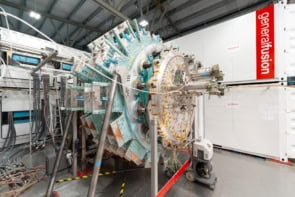Powering the Future: How we Will (Eventually) Solve the Energy Crisis and Fuel the Civilization of Tomorrow
Robert B Laughlin
2011 Basic Books $24.99hb 224pp

As the presidential election campaign hots up here in the US, it is inevitable that energy issues will loom large on the political agenda. Being Americans, our focus will inevitably be local and short term, although I admit to hoping that maybe – just maybe – this time around, politicians on both sides will finally tell the public what they mean by “clean energy”. Right now, I haven’t got a clue.
Putting such limited optimism aside, however, it is clear that energy strategies for the future will pose challenges far beyond the next election (and the next, and the next…), and not only for those of us living in North America. By the year 2100 our planet’s population will exceed 10 billion souls, all striving for a North American or European standard of living, with its attendant thirst for energy. This is a staggering (and likely unsustainable) prospect, but it is just this scenario that the Stanford University physicist and Nobel laureate Robert Laughlin addresses in his book Powering the Future.
As with any complex and fundamentally nonlinear physics problem, the devil is always in the details. Fortunately, Bob Laughlin is a details kind of guy. His subtitle, “How we Will (Eventually) Solve the Energy Crisis and Fuel the Civilization of Tomorrow”, tells us who that devil is, and that he or she resides within the parenthetical remark “eventually”. Through 11 chapters and accompanying notes (which make up half of the book’s total 224 pages), Laughlin guides us through the jungle of the energy economy: from coal to its combustion; gas to gasoline (petrol); fission dynamite to deuterium fusion; the transport of energy by electrons and protons; the possible future generation of electricity and fuels from waste substances such as manure and maize husks; and prospects for exploiting sources of energy that stem from cosmic radiation or pressures from within the ocean depths.
All of these processes are governed by a “Jungle Law”, the title of Laughlin’s third chapter. This chapter resonated with me personally, as it reflects my own metamorphosis from an industrial basic-research physicist to someone concerned with energy and the environment. Determining the direction of the energy enterprise is not like creating the market behind the next iToy, where scientific and technical matters are paramount. With energy, science plays at best a 50% role, the remainder being driven by raw economics skewed by political and social perceptions. Realizing this was an epiphany indeed.
Laughlin gives readers a great example of such an energy epiphany in his chapter on “Carbon fever”. Seven decades ago, Linus Pauling taught us the marvels of the 2s–2p hybridization of carbon’s outer shell, which lie behind all of the element’s subsequent manifestations, from life to locomotion. Laughlin points out that the economics and physics of energy production from loosely bound carbon – in whatever form it is found, whether mineral, gaseous or organic – is overwhelmingly favourable compared with those of other “alternatives”. Because of this simple fact, it is very likely that we humans will continue to oxidize pretty much every atom of available number six we can find.
Fortunately, there is a lot of mineral and organic carbon around, and this is likely to remain true at least for a while. A problem may arise in dealing with the element’s greenhouse-gas form, carbon dioxide, although some economists have argued that the wealth created and banked by using fossil fuels to their limit could underwrite whatever climate-change adaptation technologies may be needed in the next century. Regardless of your views on carbon dioxide and climate change, though, we are likely to run out of the useful forms of cheaply available carbon sometime in the next 40–60 years. Then what? The first half of this book provides some hints of the answers, and for that reason alone, it should be mandatory reading for the next president of the US and their cabinet, and for those who follow – even if one or more of them does possess a Nobel Prize for Physics.
For readers who do not have enough time for the entire book, let alone Laughlin’s extensive endnotes (which, though great for physicists, can be tedious for non-specialists), I strongly recommend at least perusing the chapter “Inspiring mammoths”. The title is a Laughlin-euphemism for nuclear energy of any origin, and in the chapter he explains that the chief economic barrier to a renaissance of nuclear-fission power is the expanding availability of coal and natural-gas reserves worldwide. There are other hurdles too, but they are mostly political and environmental in origin. The political argument against nuclear fission encompasses some sound concerns, such as weapons proliferation, and Laughlin suggests that these should be addressed by international enforcement, not just agreement. The environmental arguments, in contrast, essentially stem from a lack of proper perspective. It is instructive to point out that the death toll from a single commercial airline crash is approximately twice that of the confirmed number of radiation-exposure deaths from every nuclear-plant disaster to date, including Chernobyl and Fukushima. As far as we know, the toll from the latter remains zero (see our May feature article).
Concerns about running out of “burnable” fission material – for example uranium and thorium ore – seem likewise overblown based on Laughlin’s analysis, which also covers issues of waste, reprocessing and “breeding” fissile material in specialist reactors. Given the vast amounts of uranium and thorium in the earth and the sea, the extension of such supplies through deployment of the above technologies, and the economic drivers that will come into play with the soaring costs of exploiting disappearing fossil reserves, my “take home” message from Powering the Future is that uranium and thorium nuclei will probably be the source of the parenthetical “eventually” in the book’s subtitle. What about fusion? Well, judging from Laughlin’s “Inspiring mammoths” chapter, fusion could indeed be the energy of the future – but it will likely remain so for a long time.
Those of us who are personally acquainted with Bob Laughlin know him as a colourful character. In New York, where I grew up, we would call him, warmly, a “wise guy”. It is just this delightful attitude that makes his book so readable, and I can think of no better way to illustrate this than to quote his words in the book’s closing sentences. After thoroughly exploring present and foreseeable energy resources for humanity, Laughlin ends with a prosaic, but most profound, warning that “The most terrible cosmic explosion of all will occur if I show up late again for dinner. It might be a good idea to stop worrying about the universe and hustle home.”



